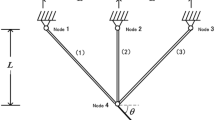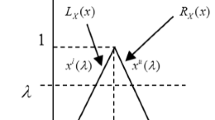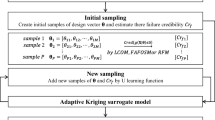Abstract
Structural reliability design optimization under epistemic uncertainty has attracted the attention of many researchers, which plays a pivotal role both in theory and engineering application. However, many traditional fuzzy reliability indicators are formulated by fuzzy measure without self-duality. For this reason, we reconsider structural system with fuzzy parameters, and a new credibilistic failure indicator (CFI) is presented based on self-dual credibility measure, which provides the exact expression of structural failure degree under fuzzy environment. Then, for the structure with fuzzy trapezoidal parameters, the explicit expressions of the CFI formulations are presented under fuzzy linear limit-state function and nonlinear limit-state function. Furthermore, CFI-based design optimization is formulated to obtain the optimal structural design under the given reliability level. Meanwhile, one theorem on the reliability constraint is provided to facilitate us to obtain the equivalent deterministic constraint of the reliability constraint. Finally, two illustrative examples are performed to demonstrate the efficiency of the proposed CFI formulation and the corresponding computational methods.



Similar content being viewed by others
References
Au SK, Beck JL (2003) Important sampling in high dimensions. Struct Saf 25(2):139–163
Breitung K (2015) 40 years FORM: some new aspects? Probab Eng Mech 42:71–77
Chakraborty S, Sam PC (2007) Probabilistic safety analysis of structures under hybrid uncertainty. Int J Numer Methods Eng 70:405–422
Cornell CA (1969) A probability-based structural code. J Am Concr Inst 66(12):974–985
Du X (2008) Unified uncertainty analysis by the first order reliability method. J Mech Des 130:091401
Gong Q, Zhang J, Tan C, Wang C (2012) Neural networks combined with importance sampling techniques for reliability evaluation of explosive initiating device. Chin J Aeronaut 25(2):208–215
Hurtado JE, Alvarez DA, Ramírez J (2012) Fuzzy structural analysis based on fundamental reliability concepts. Comput. Struct. 112–113:183–192
Li L, Lu Z (2014) Interval optimization based line sampling method for fuzzy and random reliability analysis. Appl. Math. Model. 38:3124–3135
Li W, Liu Y, Chen Y (2018) Modeling a two-stage supply contract problem in a hybrid uncertain environment. Comput Ind Eng 123:289–302
Liu B, Liu YK (2002) Expected value of fuzzy variable and fuzzy expected value models. IEEE Trans. Fuzzy Syst 10:445–450
Liu YK (2018) Credibility measure theory—a modern methodology of handling subjective uncertainty. Science Press, Beijing
Melchers RE (1999) Structural reliability analysis and prediction. Wiley, Chichester
Möller B, Graf W, Beer M (2000) Fuzzy structural analysis using \(\alpha \)-level optimization. Comput Mech 26:547–565
Möller B, Graf W, Beer M (2003) Safety assessment of structures in view of fuzzy randomness. Comput. Struct. 81:1567–1582
Mourelatos ZP, Zhou J (2005) Reliability estimation and design with insufficient data based on possibility theory. AIAA J 43(8):1696–1705
Rackwitz R (2001) Reliability analysis—a review and some perspectives. Struct Saf 23(4):365–395
Ren Y, Xiang J (2014) Crashworthiness uncertainty analysis of typical civil aircraft based on Box-Behnken method. Chin J Aeronaut 27(3):550–557
Savoia M (2002) Structural reliability analysis through fuzzy number approach, with application to stability. Comput Struct 80:1087–1102
Tang ZC, Lu ZZ, Hu JX (2014) An efficient approach for design optimization of structures involving fuzzy variables. Fuzzy Sets Syst 255:52–73
Valdebenito MA, Pérez CA, Jensen HA, Beer M (2016) Approximate fuzzy analysis of linear structural systems applying intervening variables. Comput Struct 162:116–129
Wang X, Wang L, Qiu Z (2013) Safety estimation of structural systems via interval analysis. Chin J Aeronaut 26(3):614–623
Yang G, Liu Y (2017) Optimizing an equilibrium supply chain network design problem by an improved hybrid biogeography based optimization algorithm. Appl Soft Comput 58:657–668
Yang X, Gao J (2017) Bayesian equilibria for uncertain bimatrix game with asymmetric information. J Intell Manuf 28(3):515–525
Acknowledgements
This research was supported by the National Natural Science Foundation of China (No. 51675026).
Author information
Authors and Affiliations
Corresponding author
Ethics declarations
Conflict of interest
The authors declare that there is no conflict of interest regarding the publication of this article.
Human and animals rights
This article does not contain any studies with human participants or animals performed by any of the authors.
Additional information
Communicated by Y. Ni.
Publisher's Note
Springer Nature remains neutral with regard to jurisdictional claims in published maps and institutional affiliations.
Rights and permissions
About this article
Cite this article
Zhai, H., Zhang, J. A credibilistic failure indicator for modeling structural reliability design optimization. Soft Comput 24, 2609–2615 (2020). https://doi.org/10.1007/s00500-019-03781-2
Published:
Issue Date:
DOI: https://doi.org/10.1007/s00500-019-03781-2




